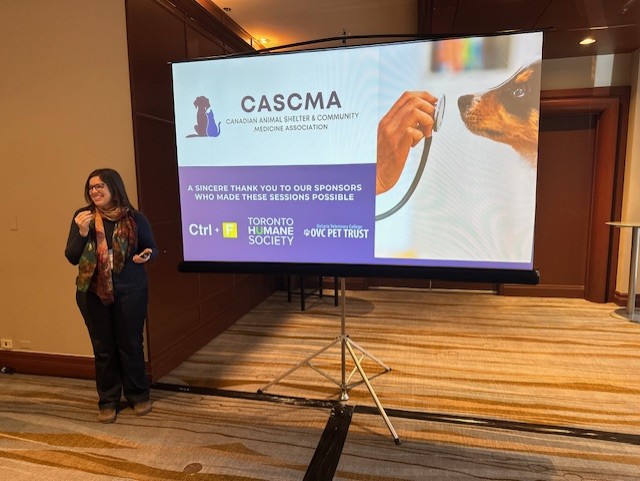
Written by Dr. Cynthia Minter
CASCMA recently hosted two engaging events focused on the topic of advanced surgery for general practitioners. The first event was an informal roundtable discussion and Q&A at Toronto Humane Society attended by both shelter veterinarians and private practice veterinarians. The second event was an afternoon lecture track at the Ontario Veterinary Medical Association (OVMA) conference.
Both events featured speakers Dr. Stephanie Sabshin and Dr. Carl Porter. Dr. Sabshin is the founder and Executive Director of Harmony Vet Care, a full-service non-profit hospital in Tampa, Florida. She has worked in both private practice and shelter medicine and opened Harmony Vet Care to increase access to high-quality medical and surgical care. Dr. Porter is a diplomate of the American College of Veterinary Surgeons and is a staff surgeon at Toronto Veterinary Emergency Hospital. He frequently provides consults and support to veterinarians at Toronto Humane Society and Toronto Animal Services, which gives him a unique perspective of working within a referral setting but being attuned to the challenges of non-profits and owners who are trying to maximize patient outcomes while working within a tight budget and other limitations.
A theme throughout the roundtable discussion was that while there is a pressing need for increased access to all types of veterinary care, urgent surgical procedures are often particularly difficult for clients to access and an inability to get this type of care can frequently lead to surrender or euthanasia. Many surgical diseases are urgent and unexpected, resulting in a tight deadline for owners to find sufficient funds or find a clinic offering the care within their budget. Additionally, an increasing shift towards a culture of referral, particularly in urban areas where referral centers are geographically accessible, results in owners who could potentially pay general practice rates searching for a veterinarian willing to offer the procedure at their clinic. Empowering general practitioners and veterinarians at non-profit community clinics to learn and offer these surgeries for clients who don’t wish to seek referral will increase the availability of these procedures and reduce the number of clients who must resort to relinquishing their pet.
Other topics discussed at the workshop included:
- Outpatient pain management options for amputations or other major surgeries
- Differences in attitudes towards NSAID use and side effects in the United States compared to Canada
- Relative necessity of bloodwork prior to post-operative NSAID use
- When amputation should be recommended for orthopedic injuries and whether we turn to amputation too soon when primary repair is not an option
- Techniques for linear foreign bodies
- Prognosticating foreign body patients and reducing dehiscence rates
- Surgical tips for feline perineal urethrostomy
- Best management of feline urethral obstruction in various settings
- How much dentistry is appropriate for shelters to perform prior to putting animals forward for adoption
- Whether performing dentistry without radiographs is acceptable and still beneficial if radiography is not available
The following day, Drs. Porter and Sabshin spoke at the OVMA conference, giving three lectures:
Empowering General Practitioners: Paws-itive Outcomes by Performing Complex Surgeries In-House
Dr. Sabshin spoke about three surgeries that are commonly needed to treat medical emergencies but are typically referred to specialists: perineal urethrostomy in cats, scrotal urethrostomy in dogs, and intestinal surgery for foreign body obstructions. With a bit of additional training and practice, these procedures can be confidently performed by general practitioners with good outcomes. Much of the lecture focused on step-by-step techniques for these three procedures. Dr. Sabshin has surgical videos available for these procedures and more on the Harmony Vet Care YouTube page.
To Stitch or Not to Stitch: Purr-fecting Wound Care Decisions in General Practice
Dr. Porter spoke about primary closure and Dr. Sabshin spoke about second intention healing and delayed closure. Primary closure is most appropriate for fresh wounds with minimal tissue trauma, and success is greatly improved by managing dead space with closed suction drains when necessary. Second intention healing is best used for older or infected wounds, or those where closure would result in excessive tension. Bandages or tie-over bandages may be options depending on the location of the wound to help protect the tissue and support healing.
Needs a Plate, Right? Or Does It?
Dr. Porter spoke on the topic of fracture management when referral to a specialist is not accessible, or the client has declined this option. He pointed out that the body is designed to heal bones and, in most cases, will do this without our help. The question then becomes how functional and comfortable the resulting limb is, and how comfortable the animal is during the healing process. Patient factors (age, size, comorbidities) as well as fracture factors (location, configuration, duration, concurrent soft tissue injury) are considerations in determining which fractures are more amenable to conservative management and which are unlikely to go well with a non-surgical approach and are better suited to a salvage surgery (such as amputation) when referral is not an option.
In Conclusion
Throughout the two days of continuing education, the prevailing message was that many surgeries that may typically be thought of as referral-level procedures requiring inpatient care can have quite good outcomes even when performed as outpatient procedures, assuming appropriate case selection, good client communication, and informed consent. Ongoing collaboration between specialists, general practitioners, and shelter and community clinic veterinarians is essential to increase access to these procedures and offer different options to clients to meet their individual needs and budget.
